The Intel Xeon W-3175X Review: 28 Unlocked Cores, $2999
by Ian Cutress on January 30, 2019 9:00 AM ESTCPU Performance: Office Tests
The Office test suite is designed to focus around more industry standard tests that focus on office workflows, system meetings, some synthetics, but we also bundle compiler performance in with this section. For users that have to evaluate hardware in general, these are usually the benchmarks that most consider.
All of our benchmark results can also be found in our benchmark engine, Bench.
For our graphs, some of them have two values: a regular value in orange, and one in red called 'Intel Spec'. ASUS offers the option to 'open up' the power and current limits of the chip, so the CPU is still running at the same frequency but is not throttled. Despite Intel saying that they recommend 'Intel Spec', the system they sent to us to test was actually set up with the power limits opened up, and the results they provided for us to compare to internally also correlated with that setting. As a result, we're providing both sets results for our CPU tests.
PCMark 10: Industry Standard System Profiler
Futuremark, now known as UL, has developed benchmarks that have become industry standards for around two decades. The latest complete system test suite is PCMark 10, upgrading over PCMark 8 with updated tests and more OpenCL invested into use cases such as video streaming.
PCMark splits its scores into about 14 different areas, including application startup, web, spreadsheets, photo editing, rendering, video conferencing, and physics. We post all of these numbers in our benchmark database, Bench, however the key metric for the review is the overall score.
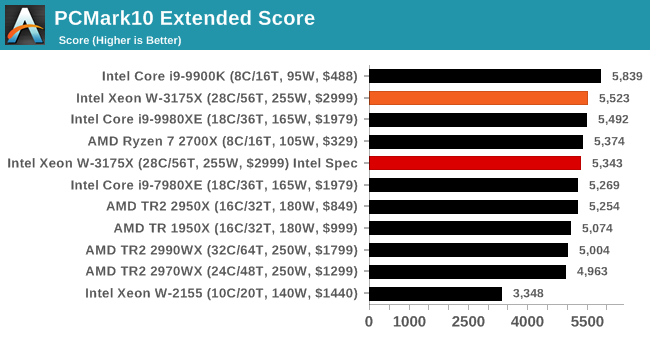
.
Chromium Compile: Windows VC++ Compile of Chrome 56
A large number of AnandTech readers are software engineers, looking at how the hardware they use performs. While compiling a Linux kernel is ‘standard’ for the reviewers who often compile, our test is a little more varied – we are using the windows instructions to compile Chrome, specifically a Chrome 56 build from March 2017, as that was when we built the test. Google quite handily gives instructions on how to compile with Windows, along with a 400k file download for the repo.
In our test, using Google’s instructions, we use the MSVC compiler and ninja developer tools to manage the compile. As you may expect, the benchmark is variably threaded, with a mix of DRAM requirements that benefit from faster caches. Data procured in our test is the time taken for the compile, which we convert into compiles per day.
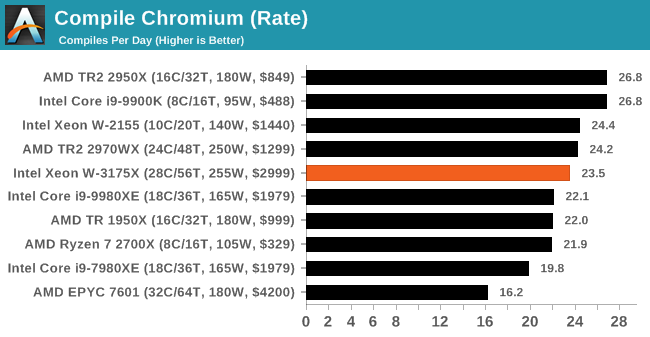
.
3DMark Physics: In-Game Physics Compute
Alongside PCMark is 3DMark, Futuremark’s (UL’s) gaming test suite. Each gaming tests consists of one or two GPU heavy scenes, along with a physics test that is indicative of when the test was written and the platform it is aimed at. The main overriding tests, in order of complexity, are Ice Storm, Cloud Gate, Sky Diver, Fire Strike, and Time Spy.
Some of the subtests offer variants, such as Ice Storm Unlimited, which is aimed at mobile platforms with an off-screen rendering, or Fire Strike Ultra which is aimed at high-end 4K systems with lots of the added features turned on. Time Spy also currently has an AVX-512 mode (which we may be using in the future).
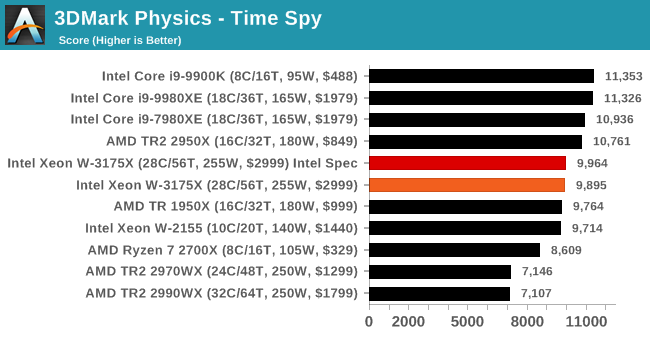
.
GeekBench4: Synthetics
A common tool for cross-platform testing between mobile, PC, and Mac, GeekBench 4 is an ultimate exercise in synthetic testing across a range of algorithms looking for peak throughput. Tests include encryption, compression, fast Fourier transform, memory operations, n-body physics, matrix operations, histogram manipulation, and HTML parsing.
I’m including this test due to popular demand, although the results do come across as overly synthetic, and a lot of users often put a lot of weight behind the test due to the fact that it is compiled across different platforms (although with different compilers).
We record the main subtest scores (Crypto, Integer, Floating Point, Memory) in our benchmark database, but for the review we post the overall single and multi-threaded results.
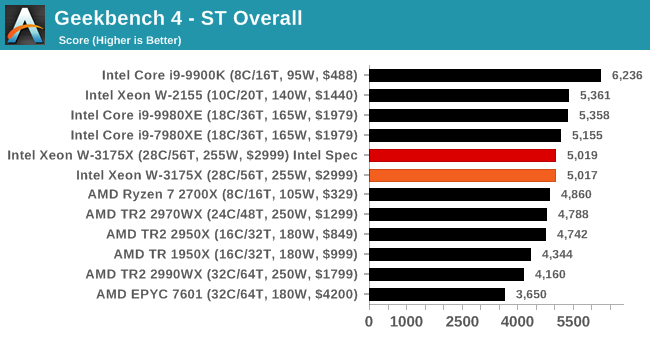
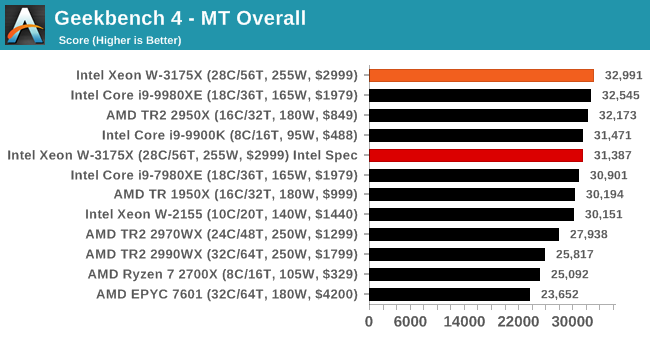










136 Comments
View All Comments
Madvocal1 - Monday, February 4, 2019 - link
Ian and readers, The ASUS ROG motherboard looks great the Intel 28 cores seem like a beast to, your scores might be way better if you contact ASUS and have them help you because you sound confused on what to set in BIOS and how to run high end system correctly.MikeV8 - Wednesday, February 6, 2019 - link
3175X Intel’s biggest chip ever? Not really. You're missing it's predecessor from 1995 - the legendary Pentium Pro for Socket 8, which is even bigger that the Threadripper. Or maybe you're too young to remember even the Pentium II Xeon which superseded Pentium Pro in 1998.Ah, I miss good old days with Anand Lal Shimpi.
MackerVII - Tuesday, March 19, 2019 - link
I'm sure someone mentioned this already....Everyone is complaining so much about how expensive this processor is but I have two points to mention.
- It's pretty much the same as Intel's top Xeon the 8180 which is a $10,000 processor.
- AMD's processor is basically a fake, 4 processors in one (and I love AMD).
So now a consumer can buy Intel's best Server processor for $7,000 less.
ADVenturePO - Saturday, May 4, 2019 - link
Well, this is heavy price. Maybe fair, but availability is a madness. But taking in account LC i9--7980XE is the best here. It kills competition with speeds. On LC it can be clocked after precise regulation of voltages up to 4.8GHz and up to 4.7GHz with 128GB of 3200MHz RAM.I'm selling stations like that. Easy to build, easy to run, easy to cool. MBs at stock.
That chip is just a showoff .
urbanman2004 - Saturday, May 18, 2019 - link
AMD's "EPYC" is gonna cause Intel a epic faileqlrutaoyqsm - Tuesday, August 25, 2020 - link
http://bitly.com/zoom-viber-skype-psy